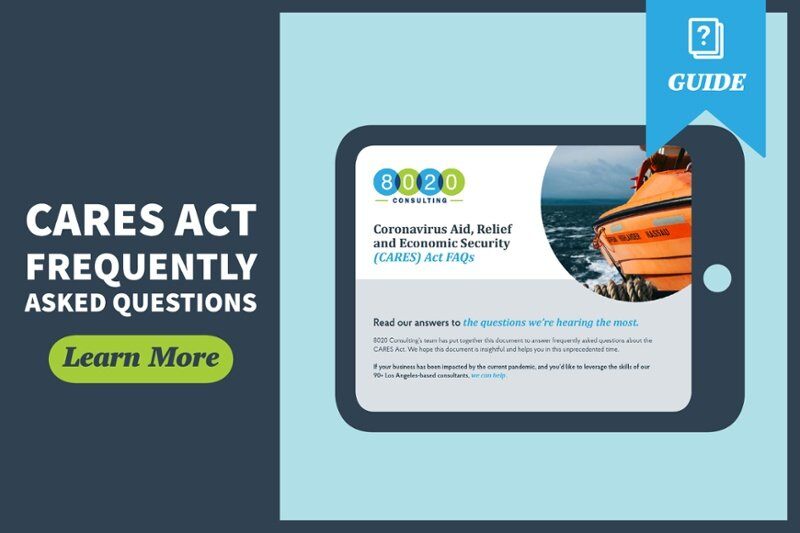On March 27, 2020, the CARES Act was signed into law in order to address the unprecedented public health and economic crisis. This act is the third round of the government’s coronavirus economic stabilization legislation and totals $2 trillion.
A significant component of the stimulus package involves loans issued under the purview of the Small Business Administration. These loans are part of the SBA’s Paycheck Protection Program (“PPP”). A key feature of these loans is forgivability. If the loans are spent on certain activities, and within certain constraints, the loans (principal and interest) will be forgiven. Because forgiveness is based on what happens within an eight-week period beginning at loan origination, it’s imperative to have a process and plan in place.
5 Tips to Maximize Loan Forgiveness
Tip #1: Deposit the PPP loan into a new bank account.
Avoid potential issues from commingling your PPP loan with other cash. Make it painstakingly clear how the proceeds were used by using a separate account.
Tip #2: Understand forgivable expenses.
Forgiveness is determined by how the loan proceeds are spent within the next eight-week period beginning at loan origination date. Forgivable expenses are payroll cost (salary, bonuses, and benefits), rent, mortgage interest, and utilities. Over the eight-week period immediately after receiving the PPP loan, payroll cost must account for at least 75% of the forgiven amount. For example, to qualify for PPP loan forgiveness, a Company that received a $1 million PPP loan, must spend at least $750,000 on payroll cost in the eight-week period immediately after receiving the PPP loan.
Tip #3: Understand items that will reduce the forgivable amount.
The forgivable amount is reduced if the company does not maintain its employee count or salary levels:
- Maintain Number of Employees: To qualify for maximum forgiveness, the company must maintain its average full-time equivalent (“FTE”) count throughout the eight-week measurement period. If this is not met, the company may restore the average FTE by June 30, 2020 to avoid being penalized. If neither of these criteria is met, the forgivable amount is reduced proportionally by an amount equal to the proportional reduction in FTEs.
- Maintain Pay Levels: Salaries must be maintained to within at least 75% when compared with the most recent quarter employees were paid. Any salary reduction more than 25% results in a dollar for dollar reduction to the forgivable amount. This requirement only applies to employees whose annual salary is less than $100,000. Employees earning more than $100,000 are excluded from this consideration.
Restoring the average FTE by June 30, 2020 is fairly straightforward and may be relatively easy to accomplish. Maintaining and/or restoring pay levels will require additional analytical work to ensure maximum loan forgiveness. If salaries have not been reduced and will be maintained, this will be an easy consideration to satisfy. However, if salaries have been reduced, or if the company is planning to reduce pay levels, the company should be evaluating salaries with the most recent full quarter. It can be in the company’s interest to maintain salaries to at least 75% of their former levels because those amounts will be fully forgiven. This will entail a careful analysis of historical payroll periods against projected pay over the eight-week period.
Tip #4: Create your action plan prior to receiving the PPP loan.
Don’t wait to create your action plan. Because the clock to the eight-week period begins ticking the day you receive the loan, create your plan in advance and know exactly how the funds will be spent or used. Your plan should include rehiring people, if needed, and/or the amount of salary reductions. Timing of expenses might fluctuate based on the loan origination date, and having a plan in place will reduce anxiety and ensure maximum loan forgiveness.
Tip #5: Document all eligible expenses.
Forgivable expenses are payroll, rent, mortgage interest and utilities. As these expenses are paid over the eight-week period, save copies of the payroll records, bills/invoices, rent agreements and monthly mortgage statements as supporting documents. The lender will need to verify these amounts to forgive the loan.
Learn More or Get Support
Understanding the details of loan forgiveness should be a key consideration for anyone applying for a PPP loan under the CARES Act. Planning ahead can ensure maximum forgiveness. 8020 Consulting has a team of professionals who can assist and partner your Company through every step of the PPP loan process. Learn more about our financial consulting services and how we can help your business navigate the CARES Act.

